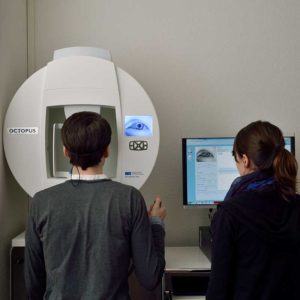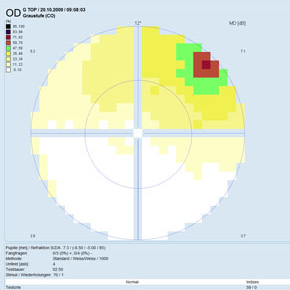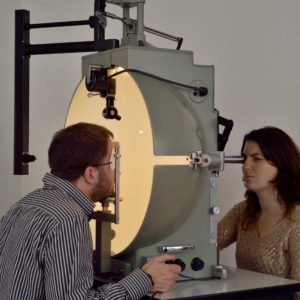Dynamic and static (computer) perimetry
The field of vision is the area that a person can perceive when fixing a point with the eye not moving (the other eye is covered). With field of vision measurement (perimetry), failures outside the central visual range can be detected and analyzed.
Such failures can be caused by various eye or brain diseases. Here are some examples: Glaucoma, eye injury, head injury, migraine attack, stroke, brain tumor, retinal damage or bleeding in the eye. The measurement can be performed with static perimetry or kinetic perimetry.

STATIC PERIMETRY (OCTOPUS)
The most commonly used method is static computer perimetry. Here the patient sits in front of a semi-circular projection screen and fixes a light in the middle of this test screen with one eye. The other eye is covered. This is when spots of light appear spontaneously at different points on the screen. If these are perceived by the patient, he/she confirms this by pressing a button. If there is no reaction to a light stimulus, the computer increases the light intensity. If there is still no reaction, this is registered as failure.
On average, static field of vision measurement take about 5 minutes per eye. A longer (dynamic) program can also be selected, which takes up to 10 minutes per eye.


KINETIC PERIMETRY (GOLDMANN)
An older variant is kinetic perimetry, which is used less frequently today. Similarly, with this method, the person to be tested sits in front of a semicircular test screen. The principle is similar to that of static perimetry, except in this case light points move from the edge of the screen towards the center. The examiner records the time at which the points are perceived in the patient’s field of vision. The result is recorded on a diagram. This evaluation shows the exact size of the field of vision. The advantage of this method is that it requires less concentration on the part of the patient and the examiner can control attention precisely.
The eyes are tested individually, with the second eye covered. On average, the kinetic field of vision measurement takes 5 to 10 minutes per eye.

